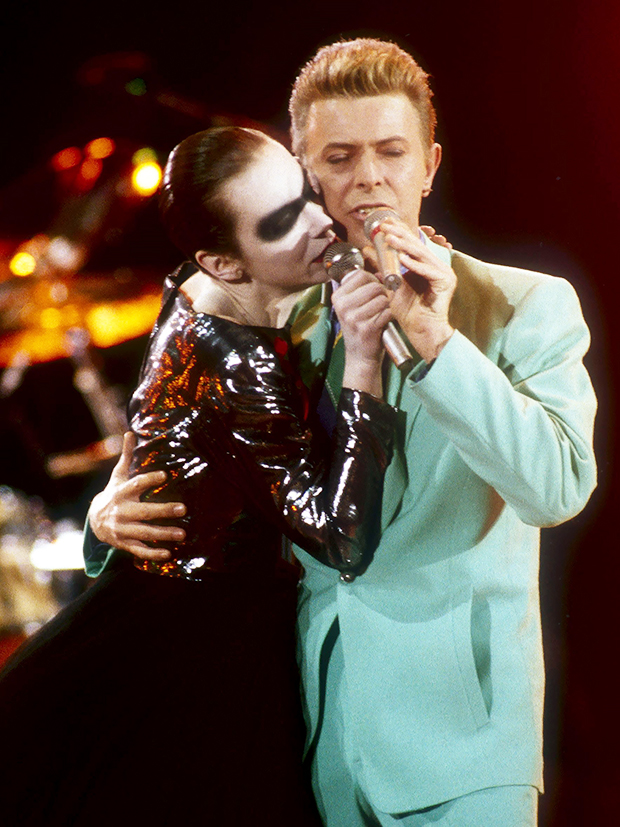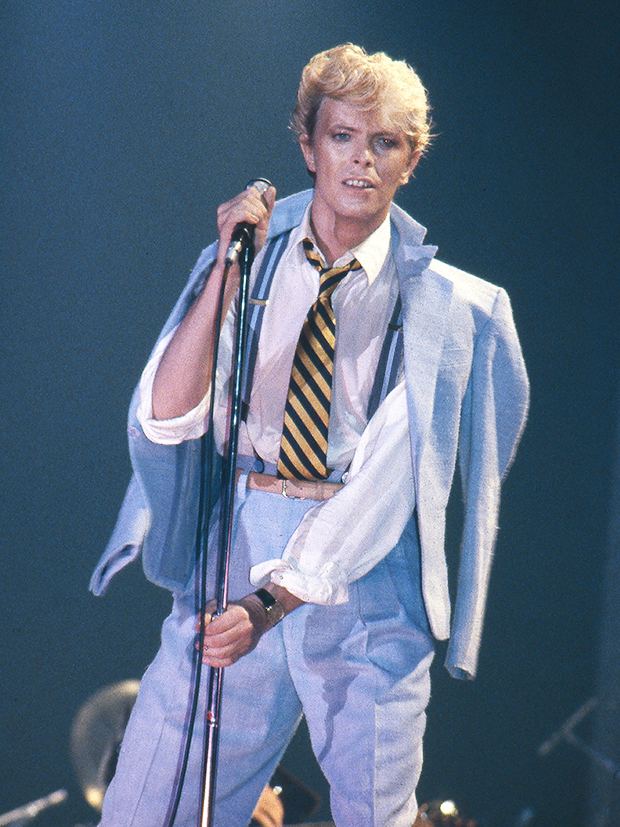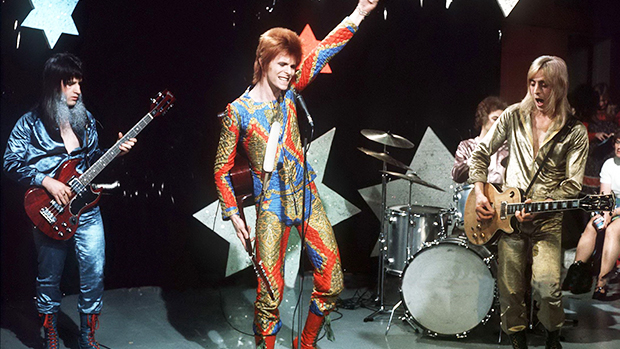Today marks what would have been David Bowie’s 75th birthday, so listen to some of his best songs – and discover why so many are still celebrating his legacy.
There never will be another person quite like David Bowie. Born David Robert Jones in 1974, the music legend would have turned 75 today, January 8. Sadly, he left this plane of existence in 2016 after a secret battle with liver cancer, dying in his New York City apartment days after his 69th birthday. Since then, the world hasn’t quite been the same, and many are celebrating today by playing his music, watching his movies, and remembering the impact he had during his time on this Earth. But, for those unfamiliar with his work, where to start?
After all, Bowie left behind more than 25 full-length studio albums, including Blackstar, the album released on his birthday in 2016. Written and recorded during his final days, Blackstar is considered a triumphant send-off to a phenomenal career and a parting gift to his fans. The critically-acclaimed album is regarded as one of his bests, but is that where a Bowie novice should start? For those who would love a starter sample of Bowie’s incredible and diverse career, here’s a list of twelve songs that capture the man’s genius and charisma.

For those interested in what to do after pursuing this selection, the David Bowie estate has launched Bowie 75, a year-long celebration of his legacy. Two curated experiential pop-up shops in London and New York City will offer a “unique and immersive career-spanning deep dive” of his career, including immersive audio and HD video screening rooms in partnership with 360 Reality Audio. These locations will allow fans to listen and see Bowie content in a lifelike music experience as if you were witnessing a David Bowie concert for yourself.
These pop-up shops will also give fans access to hours of previously unseen video concert footage, including rare footage from his Heathen and Reality eras. Fans can also place themselves in some of Bowie’s iconic outfits and costumes for social media moments, purchase limited-edition apparel and collectibles, and view exclusive fine art galleries celebrating his many iconic eras. More details can be found here.
“Space Oddity”
It’s arguably David Bowie’s most important song. Without “Space Oddity,” from David’s second self-titled album, the incredible 47-year career that came afterward wouldn’t have happened. Though the song peaked at No. 15 in the U.S., it topped the U.K. singles charts. His label rushed out the song to coincide with the Apollo 11 moon landing, but David says it wasn’t inspired by the Americans landing on the moon in 1969.
“It was written because of going to see the film 2001, which I found amazing,” he told Performing Songwriter in January 2016. “I was out of my gourd anyway, I was very stoned when I went to see it, several times, and it was really a revelation to me. It got the song flowing. It was picked up by the British television and used as the background music for the landing itself. I’m sure they really weren’t listening to the lyric at all.”
“The Man Who Sold The World”
David’s follow-up to “Space Oddity,” “The Prettiest Star,” failed to chart, putting Bowie at risk of becoming a one-hit-wonder. Sensing his failing power as a solo act, he formed a band with bassist Tony Visconti, who had worked with Bowie since 1968 and would produce and occasionally play with him until David died in 2016. Along with drummer Mick Woodmansey and guitarist Mick Ronson, Bowie and Visconti formed the backing band that would eventually become the Spiders from Mars.
Their first outing would be The Man Who Sold The World, a dramatic, creative departure from Bowie’s earlier folk music. The title track became an anthem for GenXers when Nirvana covered it for their MTV Unplugged concert. The alienation at the heart of the song struck a chord with Nirvana’s Kurt Cobain.
“I guess I wrote it because there was a part of myself that I was looking for,” Bowie said of “The Man Who Sold The World” while talking to BBC Radio in 1997, per Esquire. “That song for me always exemplified kind of how you feel when you’re young, when you know that there’s a piece of yourself that you haven’t really put together yet. You have this great searching, this great need to find out who you really are.”
“Five Years”
The Spiders from Mars briefly called it quits with Bowie after a personal dispute with the artist, but rejoined him for 1971’s Hunky Dory, with Trevor Bolder replacing the departed Visconti. The group would hone this glam-rock skill on the next album, The Rise and Fall of Ziggy Stardust and the Spiders from Mars. This album would also see Bowie adopt his first persona. As Ziggy, he would craft a character that, as he told PBS in 2014, was “half out of sci-fi rock and half out of the Japanese theater.” Additional personas would include Halloween Jack, the Thin White Duke, and Major Tom.
While Ziggy Stardust contains songs that have become pop culture staples (“Starman,” “Suffragette City,” “Ziggy Stardust,” “Moonage Daydream”), perhaps the album’s opener, “Five Years,” should be considered as its best offering? The song sets the stage for the album, detailing an apocalyptic event that gives the Earth only a handful of years before annihilation.
“It has been announced that the world will end because of lack of natural resources,” Bowie said in a 1974 interview with William Burroughs for Rolling Stone. “Ziggy is in a position where all the kids have access to things that they thought they wanted. The older people have lost all touch with reality, and the kids are left on their own to plunder anything. Ziggy was in a rock’n’roll band and the kids no longer want rock’n’roll. There’s no electricity to play it.” Sadly, the theme of the song seems even more relevant today.

“John, I’m Only Dancing”
“I’m gay, and always have been, even when I was David Jones,” Bowie told Melody Maker in 1972. He made this statement while married to Angie Bowie, and months earlier, they had welcomed their son, Duncan Jones. That same year as that proud declaration, Bowie scored a Top 20 hit in the U.K. with “John, I’m Only Dancing,” a non-album single that wasn’t released in the United States. The song is widely believed to be sung from the perspective of a gay male assuring his boyfriend that he shouldn’t be worried that he’s dancing with a girl.
Initially recorded in 1972, Bowie re-recorded it in 1973 during the Aladdin Sane sessions with a slightly different arrangement and Ken Fordham on saxophone. The “sax version” is often considered better than the original, but Bowie wasn’t done re-recording the song. In 1974, he released “John, I’m Only Dancing (Again),” a disco version.
As for Bowie’s sexual orientation, while speaking with Cameron Crowe in 1976 for Rolling Stone, David said he was bisexual. “I remember the first time it got out. Somebody asked me in an interview if I ever had a gay experience, and I said, ‘Yes, of course, I am a bisexual.’ The guy didn’t know what I meant.” In 1983, while talking with Kurt Loder, again for Rolling Stone, Bowie walked back those comments. “The biggest mistake I ever made,” he said, “was telling that Melody Maker writer that I was bisexual. Christ, I was so young then. I was experimenting….”
“Panic In Detroit”
The trademark Bowie makeup – the blue and red lighting bolt across the face – comes from the cover art for Aladdin Sane. It was the first album that Bowie wrote while as a bonafide rockstar. Though the album’s most known tracks are either “The Jean Genie” or “Watch That Man,” it’s “Panic In Detroit” that celebrates Bowie’s relationship with two vital creative collaborators: guitarist Mick Ronson, and The Stooges frontman Iggy Pop.
“Panic In Detroit” shows Mick’s impressive guitar work, and Rolling Stone reportedly considered it one of his most essential recordings. The song is based on Iggy Pop’s experiences during the 1967 Detroit Riots, per Songfacts. Iggy and Bowie developed a special bond after meeting in 1971. Bowie produced Iggy’s first two solo albums, The Idiot and Lust For Life. Bowie would also help out his friend when Iggy was in dire straights and even had Pop live with him in West Germany in the late ’70s while creating the albums that would make up “The Berlin Trilogy.”
“Young Americans”
Ziggy had left his glam-rock persona behind in the mid-seventies and ditched the folk psychedelia to the moon and back. He had also scored numerous top-10 hits in the U.K. but hadn’t penetrated the Top 40 in America. That changed when he relocated to Sigma Sound Studios in Philadelphia to capture the “Philly Sound,” or soul music mixed with strings, horns, and plenty of funk. With a then-unknown Luther Vandross on backing vocals, the experiment paid off. “Young Americans” cracked the Top 40, and the album’s second single, “Fame,” would give Bowie his first No. 1 in America.
“Sound And Vision”
The “Berlin Trilogy” is Bowie’s three consecutive albums released from 1977 to 1979: Low, “Heroes,” and Lodger. Bowie wrote the trilogy in collaboration with Brian Eno and producer Tony Visconti. The art-rock triad has become beloved by critics, though at Low’s release, even some of Bowie’s biggest boosters weren’t ready for this sudden sonic switch-up.
“Sound and Vision,” the lead single from Low, also marks an odd point in Bowie’s life. Though it reached No. 3 on the U.K. Singles Chart, it peaked at No. 69 on the Billboard Hot 100, starting a commercial slump that would follow Bowie until the early ’80s. It shows that while Bowie was a critical darling, music-buying audiences didn’t always agree.
“Heroes”
If one song has become synonymous with David Bowie, it’s the title track to 1997’s “Heroes.” While the song wasn’t a commercial smash when it was first released, it’s become a powerful entry in Bowie’s catalog in the decades that followed. It was also the soundtrack to one of the most important moments in his life.
“Heroes” was written and recorded in a West Germany studio that overlooked the Berlin Wall. In 1987, two years before the wall fell, Bowie performed it live at Platz der Republik Festival, right across from the Berlin studio where he wrote it. “It was one of the most emotional performances I’ve ever done. I was in tears,” he told Classic Rock in 2015. The stage was backed against the wall, and thousands of East Berliners gathered on the opposite side to listen. Bowie heard them cheering and singing along.
“When we did ‘Heroes,’ it really felt anthemic, almost like a prayer,” Bowie continued. “I’ve never felt it like that again.”
“Scary Monsters (And Super Creeps)”
Bowie spent the 1970s establishing himself as a creative marvel. He helped pioneer glam rock with Ziggy Stardust, got soulful with the Philly sound on Young Americans, touched upon krautrock with Station to Station, and experimented with electronic music with the Berlin trilogy. At the start of the ’80s, Bowie seems to devour his past self with the album Scary Monsters (and Super Creeps).
Scary Monsters may be best known for containing “Ashes to Ashes,” the sequel to “Space Oddity” that depicted Major Tom as a “junkie, strung out in heaven’s high, hitting an all-time low.” However, there’s an urban myth surrounding the title track.
On February 8, 1997, Bowie appeared as the musical guest on an episode of Saturday Night Live. He first performed his single, “Little Wonder,” but for the second song, he oddly dipped back into his discography to play “Scary Monsters (And Super Creeps).” The legend states, per Far Out Magazine, that during a dinner with Lorne Michaels, the SNL showrunner confided in Bowie that he went through a dark time in his life and that Scary Monsters was a soundtrack to this low point. Bowie, being a little cheeky, played “Scary Monsters” to tease his friend – which allegedly resulted in Lorne banning Bowie from the show.
HollywoodLife has reached out to SNL and Lorne Michaels about the legitimacy of this rumored banning and will update this with any additional information when made available.
“Let’s Dance”
Bowie is and remains a music legend and pop culture icon, but he only had two No. 1 hits on the Billboard Hot 100, the last being the title track to his 1983 album, Let’s Dance.
Written by Bowie and produced by Nile Rodgers of the band Chic – who also co-produced the record – “Let’s Dance” was Bowie’s most successful songs ever. “I’d had quite a number of hit records before I met Bowie, and he hadn’t really had any, then, not what I called a hit, anyway,” Nile told British GQ in 2020. “At that point, I was running from hit albums because I wanted credibility, I wanted artistic approval, for somebody to say, ‘Wow, this guy who wrote ‘We Are Family,’ ‘Good Times’ or ‘Freak Out’ is cool enough to work with David Bowie.’”
Rodgers thought that he would help Bowie make some “spacey cool jazz, prog-rock record” but found that David had some other plans in mind. “He basically commissioned me,” said Rodgers. “He said, ‘This is why I’m hiring you. I want to work with you because I want a hit and not just a single but a whole album.’”

Unfortunately, Bowie found commercial success to be a cage of his own making. “I was suddenly no longer ‘the world’s biggest cult artist’ in popular music. I went mainstream in a major way with the song ‘Let’s Dance.’ I pandered to that in my next few albums, and what I found I had done was put a box around myself,” Bowie told Interview in 1995
David said that after his chart-topping hit, it was “very hard for people to see me as anything other than the person in the suit who did ‘Let’s Dance,’ and it was driving me mad—because it took all my passion for experimenting away.”
“Jump, They Say”
After two less-than-satisfying albums (“My nadir was Never Let Me Down,” he told Interview. “It was such an awful album”), David finished out the ’80s as part of rock group Tin Machine. His first solo album of the ’90s was 1993’s Black Tie White Noise, an album Rolling Stone gave four stars while calling it “one of the smartest records of a very smart career.” Bowie told MTV News that the inspiration for Black Tie White Noise came while writing music for his and Iman’s 1992 wedding. Hoping to make music that appeased her Muslim family and his Christian family, he worked with wind instruments, saxophones, and keyboards. “Once I started writing that music, it opened up a whole other level of ideas of things I needed to write about,” he said.
“Jump, They Say” was the lead single off the album. It alludes to Bowie’s step-brother, Terry, who committed suicide in 1985. The song is Bowie rediscovering a missing creative spark or, as he told MTV News, he was “having a really good time at the moment with my own music” again.
“Little Wonder”
Released a month after Bowie’s 50th birthday, Earthling marked Bowie adopting the role of an elder statesman in music. “I wanted to see what you could do as a rock artist at fifty. Everybody else can do what they want to do, but I know what I want to do,” he said in a making-of video. “It’s extraordinarily exciting for me because I honestly don’t know what’s going to happen. Because I really feel if I had to lay back on what I’ve done before, I’d much prefer to stop. I’d really would prefer to sculpt and paint and that sort of thing.”
Referring to Bowie as a shifting chameleon of music would be a dishonor since his stylistic changes were never superficial or trend-chasing. As a lover of music, he engaged in post-punk, new wave, soul, and rock out of genuine interest. On 1995’s Outside, Bowie teamed with Pet Shop Boys to create a dance remix “Hallo Spaceboy,” the song that closed off the “Major Tom Trilogy.”
Similarly, when he adopted a jungle/drum and bass sound for Earthling’s lead single, “Little Wonder,” it was because he was “really impressed” with the techno sound in London. “I wanted to create a hybrid with jungle and rock,” he said, and that experimentation produced “Little Wonder.” The music video also paid homage to Bowie’s past, featuring versions of his Ziggy Stardust and Halloween Jack personas.
There will likely never be another artist like David Bowie. On today, his 75th birthday, celebrate this cosmic star who fell to Earth and blessed us with his vision by enjoying his music. It might blow your mind, but as Ziggy said, it’s all worthwhile.
